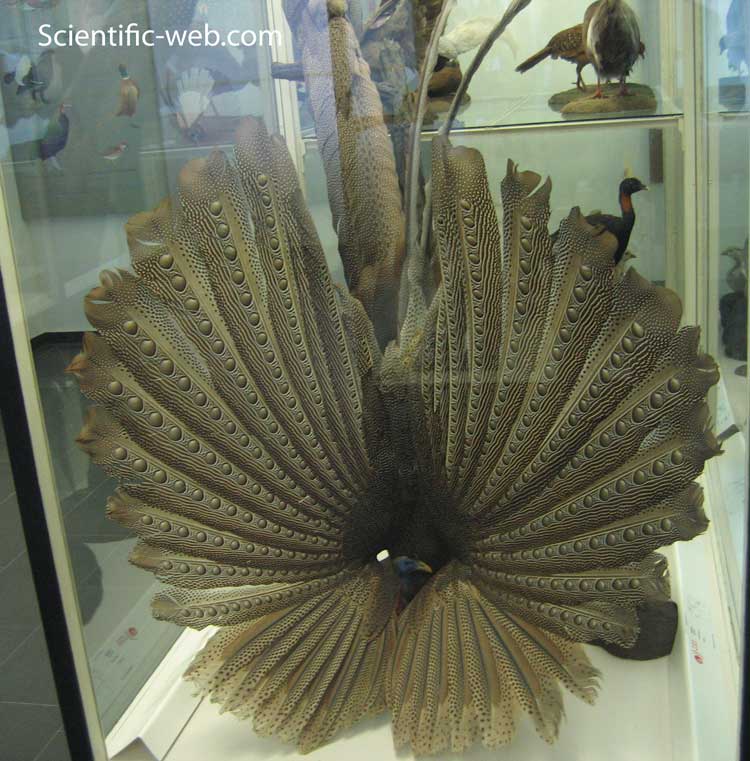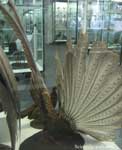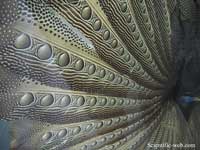
Great Argus , Argusianus argus, Photo: Michael Lahanas
Superregnum: Eukaryota
Cladus: Unikonta
Cladus: Opisthokonta
Cladus: Holozoa
Regnum: Animalia
Subregnum: Eumetazoa
Cladus: Bilateria
Cladus: Nephrozoa
Superphylum: Deuterostomia
Phylum: Chordata
Subphylum: Vertebrata
Infraphylum: Gnathostomata
Megaclassis: Osteichthyes
Cladus: Sarcopterygii
Cladus: Rhipidistia
Cladus: Tetrapodomorpha
Cladus: Eotetrapodiformes
Cladus: Elpistostegalia
Superclassis: Tetrapoda
Cladus: Reptiliomorpha
Cladus: Amniota
Classis: Reptilia
Cladus: Eureptilia
Cladus: Romeriida
Subclassis: Diapsida
Cladus: Sauria
Infraclassis: Archosauromorpha
Cladus: Crurotarsi
Divisio: Archosauria
Cladus: Avemetatarsalia
Cladus: Ornithodira
Subtaxon: Dinosauromorpha
Cladus: Dinosauriformes
Cladus: Dracohors
Cladus: Dinosauria
Ordo: Saurischia
Cladus: Eusaurischia
Subordo: Theropoda
Cladus: Neotheropoda
Cladus: Averostra
Cladus: Tetanurae
Cladus: Avetheropoda
Cladus: Coelurosauria
Cladus: Tyrannoraptora
Cladus: Maniraptoromorpha
Cladus: Maniraptoriformes
Cladus: Maniraptora
Cladus: Pennaraptora
Cladus: Paraves
Cladus: Eumaniraptora
Cladus: Avialae
Infraclassis: Aves
Cladus: Euavialae
Cladus: Avebrevicauda
Cladus: Pygostylia
Cladus: Ornithothoraces
Cladus: Ornithuromorpha
Cladus: Carinatae
Parvclassis: Neornithes
Cohors: Neognathae
Cladus: Pangalloanserae
Cladus: Galloanseres
Ordo: Galliformes
Familia: Phasianidae
Subfamilia: Phasianinae
Genus: Argusianus
Species: Argusianus argus
Subspecies: A. a. argus – A. a. grayi
Name
Argusianus argus (Linnaeus, 1766)
Synonyms
Phasianus argus (protonym)
References
Systema Naturae ed.12, p.272
IUCN: Argusianus argus (Vulnerable)
Vernacular names
čeština: Argus okatý
Deutsch: Argusfasan
English: Great Argus
magyar: Argus-páva
Bahasa Indonesia: Kuau Raja
日本語: セイラン
Bahasa Melayu: Burung Kuang Raya
Nederlands: Argusfazant
polski: Argus malajski
svenska: Större argusfasan
ไทย: นกหว้า
Türkçe: Büyük argus
中文: 大眼斑雉
The great argus (Argusianus argus) is a species of pheasant from Southeast Asia.
It is not to be confused with the two species of closely related crested argus, genus Rheinardia.
Taxonomy
Feathers of Argus ocellatus (synonym for the crested argus Rheinardia ocellata) and Argus bipunctatus (fourth)
Carl Linnaeus gave the great argus its specific name (from which its common name and genus name are derived) because of the intricate eye-like patterns on its wings, in reference to Argus, a hundred-eyed giant in Greek mythology. There are two subspecies recognized: Nominate argus of the Malay peninsula and Sumatra, and A. a. grayi of Borneo. William Beebe considered the two races to be distinct species, but they have since been lumped.[citation needed]
Double-banded argus
The double-banded argus (Argusianus bipunctatus), known only from a portion of a single primary flight feather, was long considered a potential second species.[4][5] It was described in 1871 from this feather piece, found in a millinery shipment imported to London. Its origin was hypothesized to be from Java, Indonesia or Tioman Island of Malaysia, because of the great argus's absence from these locations. Parkes (1992) rejected the double-banded argus's validity and argued that it almost certainly represents a mutant form of the great argus. The IUCN, following the precautionary principle, listed this taxon as extinct until 2012. It was removed from the IUCN Red list because the IOC had removed this species from its list of valid bird taxa in 2011. While the feather is indeed quite distinct, it represents a fairly simple divergence: The entirely asymmetrically-patterned vanes are instead near-symmetrical, and both bear the darker brown shaftward area with dense whitish speckles. The shaft is thinner than usual and the feather would probably not have been useful for flight.[citation needed]
Nothing similar has come to notice ever since, and as the feather piece is not a composite of two feather halves glued together but an apparently natural specimen, a hoax or fake can be ruled out. Despite all conjecture that has been built around the feather piece, all that can be said is that at some time around 1870, an argus pheasant which bore at least one such feather was shot in an unknown location. Even if this individual was one of the last remnants of a now-extinct population, it is unlikely that only a single feather would have been taken from an unusual specimen of a well-known, often-hunted, and conspicuous bird, and that this single feather would have then been bundled into a shipment of normal great argus feathers. The feather is now housed in the Natural History Museum in London.[citation needed]
Names
Malay language: Kuang raya "great pheasant" [6]
Description
Male at Disney's Animal Kingdom
The great argus is a brown-plumaged pheasant with a blue head and neck, rufous red upper breast, black hair-like feathers on the crown and nape, and red legs. The male is one of the largest of all pheasants, measuring 160–200 cm (63–79 in) in total length, including a tail of 105–143 cm (41–56 in), and weighing 2.04–2.72 kg (4.5–6.0 lb).[7] Males have very long tail feathers and huge, broad and greatly elongated secondary wing feathers decorated with large eyespots. Young males develop their adult plumage in their third year.[8] Females are smaller and duller than males, with shorter tails and fewer eyespots. They measure 72–76 cm (28–30 in) in total length, including a tail of 30–36 cm (12–14 in), and weighs 1.59–1.7 kg (3.5–3.7 lb).[7]
Behaviour
"Argus Pheasant" drawn by T. W. Wood for Charles Darwin's 1874 book, Descent of Man
Though the great argus is not as colorful as other pheasants, its display surely ranks among the most remarkable.[according to whom?] The male clears an open spot in the forest and prepares a dancing ground. He announces himself with loud calls to attract females, then he dances before her with his wings spread into two enormous fans, revealing hundreds of "eyes" while his real eyes are hidden behind it, staring at her.[9]
Despite displays similar to polygamous birds and though the great argus was thought to be polygamous in the wild, it has been discovered that it is actually monogamous.[10]
It feeds on the forest floor in early morning and evening. Unusual among Galliformes, the great argus has no uropygial gland and the hen lays only two eggs.[11]
Distribution and habitat
The great argus is native to the jungles of Borneo, Sumatra and the Malay Peninsula in southeast Asia.[1]
Conservation
Due to ongoing habitat loss and to being hunted in some areas, the great argus is evaluated as Vulnerable on the IUCN Red List.[1] It is listed on Appendix II of CITES.
References
BirdLife International (2020). "Argusianus argus". IUCN Red List of Threatened Species. 2020: e.T22725006A183255774. doi:10.2305/IUCN.UK.2020-3.RLTS.T22725006A183255774.en. Retrieved 19 November 2021.
"Appendices | CITES". cites.org. Retrieved 2022-01-14.
William Beebe (1922). "A Monograph of the Pheasants" (PDF). p. 131. Retrieved 2017-10-19.
Parkes', K. S. (1992). "Distribution and taxonomy of birds of the world, in "Recent Literature"". Journal of Field Ornithology. 63 (2): 228–235.
Davison, G. W. H.; McGowan, Phil (2009). "Asian enigma: Is the Double-banded Argus Argusianus bipunctatus a valid species?". BirdingASIA. 12: 94.
Kamus Dewan, kuang
del Hoyo, J.; Elliott, A.; Sargatal, J. (1994). Handbook of the Birds of the World - Volume 2: New World Vultures To Guineafowl. Lynx Edicions. pp. 550–563. ISBN 8487334156.
"Great Argus Pheasants". www.beautyofbirds.com. Retrieved 2017-10-13.
Great Argus. honoluluzoo.org.
Argus Pheasant. whozoo.org: monogamous rather than polygamous.
Great Argus Pheasant. feathersite.com.
Further reading
Fuller, Errol (2000): Extinct Birds (2nd ed.). Oxford University Press, Oxford, New York. ISBN 0-19-850837-9
Retrieved from "http://en.wikipedia.org/"
All text is available under the terms of the GNU Free Documentation License



